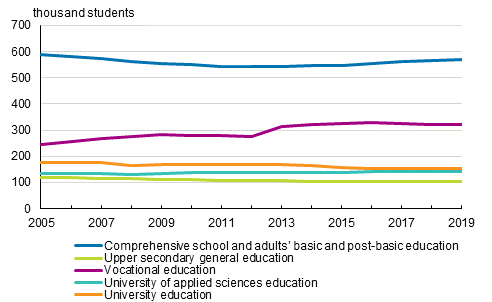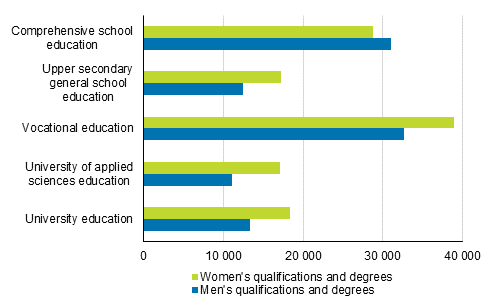Published: 26 November 2020
Students in education leading to a qualification or degree number 1.29 million
The total number of students in education leading to a qualification or degree was 1.29 million in 2019. The number is 0.3 per cent higher than in 2018. The number of students grew in comprehensive school education, upper secondary general school education, university of applied sciences education and university education. The number of students in vocational education fell. These data derive from education statistics compiled by Statistics Finland.
Students in education leading to a qualification or degree 2005–2019 1)

1) The data describe the situation on 20 September, except for data on vocational education, which are from the calendar year starting from 2013 and those on preparatory education for a skills examination and apprenticeship training from 2004 onwards.
In 2019, the number of new students totalled 290,300, which is 1.8 per cent higher than in the previous year. The number of new students declined only in comprehensive school education, in all other sectors of education the number grew: in upper secondary general school education by six per cent, in vocational education by one per cent, in universities of applied sciences education by two per cent and in university education by three per cent.
In 2019, the number of attainers of qualifications or degrees was 220,800, which is 2.7 per cent lower than in the previous year. There were fewer completers of qualifications or degrees in upper secondary general school and vocational education than in the year before, more in comprehensive school education and in university of applied sciences and university education than in the year before.
Women the majority in post-comprehensive school education
A total of 54 per cent of new students and 54 per cent of attainers of qualifications or degrees were women. Fifty-one per cent of all students were women. Women were the majority in both new students, students and attainers of qualifications or degrees in all post-comprehensive level educational sectors.
Altogether, 71,600 students completed a vocational qualification in 2019. Fifty-four per cent of them were women. Women made up 52 per cent of attainers of initial vocational qualifications, 61 per cent of attainers of vocational qualifications and 58 per cent of attainers of specialist vocational qualifications.
In 2019, altogether 58 per cent of the completers of both the matriculation examination and a university degree were women.
Qualifications and degrees completed by women and men in 2019

Foreign and foreign-language speaking students
In 2019, altogether 50,100 foreign students attended post-comprehensive education leading to a qualification or degree. This corresponds to seven per cent of all students. Foreign students refer to persons whose nationality is other than Finnish. The number of foreign students was highest in vocational education, nine per cent, and lowest in upper secondary general school education, two per cent. Seven per cent of students in university of applied sciences education and university education were foreign students.
In 2019, altogether 78,200 foreign-language speaking students attended post-comprehensive education leading to a qualification or degree. This corresponds to 11 per cent of all students. Foreign-language speaking student refers to a person whose mother tongue is not Finnish, Swedish or Sami. In upper secondary general education seven per cent were foreign-language speaking students, in vocational education 13 per cent and in both university of applied sciences education and university education 10 per cent.
The statistics on students and qualifications of educational institutions apply harmonised concepts and classifications to draw an overall picture of education leading to a qualification or degree. The statistics contain data on all sectors of education. Data on the subject matter are also published in the database tables of these statistics, and on the web pages of the statistics on pre-primary and comprehensive school education, upper secondary general education, vocational education, university of applied sciences education, university education, and adult education of educational institutions. In addition to these, the statistics on the educational structure of population contain information on attainers of qualifications by gender, age group and area, for example.
Source: Education, Statistics Finland
Inquiries: Heli Hiltunen 029 551 3314, koulutustilastot@stat.fi
Head of Department in charge: Hannele Orjala
Publication in pdf-format (219.1 kB)
- Tables
-
Tables in databases
Pick the data you need into tables, view the data as graphs, or download the data for your use.
Appendix tables
Updated 26.11.2020
Official Statistics of Finland (OSF):
Students and qualifications [e-publication].
ISSN=2737-0410. 2019. Helsinki: Statistics Finland [referred: 31.12.2025].
Access method: http://stat.fi/til/opiskt/2019/opiskt_2019_2020-11-26_tie_001_en.html

